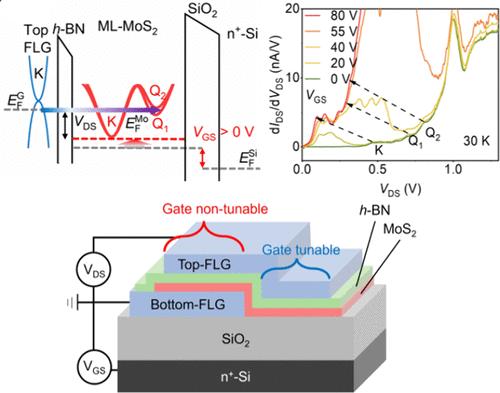门控共振隧道二极管中单层二硫化钼的探测电子带结构
IF 8.2
2区 材料科学
Q1 MATERIALS SCIENCE, MULTIDISCIPLINARY
引用次数: 0
摘要
单层过渡金属二硫族化合物(TMDCs)带结构的实验测定对TMDCs性能的设计和裁剪至关重要。共振隧道光谱(RTS)是一种通过测量态密度(DOS)和能量色散来探测低维体系能带结构的有效技术。本文报道了一种门控共振隧道二极管中单层MoS2 (ML-MoS2)的能带结构。在0.47、0.70和0.81 V的特征电流-电压曲线中分别观察到三个不同的谐振隧道结,它们对应于ML-MoS2在K、Q1和Q2点的导带局部最小值。当施加较大的正栅极电压以增强ML-MoS2的电导率时,三个谐振扭分别在0.10、0.32和0.39 V时向低偏置偏移,这与理论计算非常吻合。我们的工作为利用RTS探索TMDCs的电子能带结构提供了一种有效和更精确的方法。本文章由计算机程序翻译,如有差异,请以英文原文为准。

Probing Electronic Band Structure of Monolayer MoS2 in Gate-Controlled Resonant Tunneling Diodes
Experimental determination of band structures of monolayer transition metal dichalcogenides (TMDCs) is crucially important in the design and tailoring of the properties of TMDCs. Resonant tunneling spectroscopy (RTS) is an effective technique to probe the band structures of low-dimensional systems by measuring the density of states (DOS) and energy dispersions. Here, we report the investigation of the band structure of monolayer MoS2 (ML-MoS2) in a gate-controlled resonant tunneling diode. Three distinct resonant tunneling kinks are observed in the characteristic current–voltage curves at 0.47, 0.70, and 0.81 V, respectively, which correspond to the conduction band local minimum of ML-MoS2 at K, Q1, and Q2 points. When applying a large positive gate voltage to enhance ML-MoS2 conductivity, the three resonant kinks shift to lower bias at 0.10, 0.32, and 0.39 V, respectively, which is in excellent agreement with the theoretical calculations. Our work offers an effective and more precise way to explore the electronic band structures of TMDCs using RTS.
求助全文
通过发布文献求助,成功后即可免费获取论文全文。
去求助
来源期刊

ACS Applied Materials & Interfaces
工程技术-材料科学:综合
CiteScore
16.00
自引率
6.30%
发文量
4978
审稿时长
1.8 months
期刊介绍:
ACS Applied Materials & Interfaces is a leading interdisciplinary journal that brings together chemists, engineers, physicists, and biologists to explore the development and utilization of newly-discovered materials and interfacial processes for specific applications. Our journal has experienced remarkable growth since its establishment in 2009, both in terms of the number of articles published and the impact of the research showcased. We are proud to foster a truly global community, with the majority of published articles originating from outside the United States, reflecting the rapid growth of applied research worldwide.
 求助内容:
求助内容: 应助结果提醒方式:
应助结果提醒方式:


